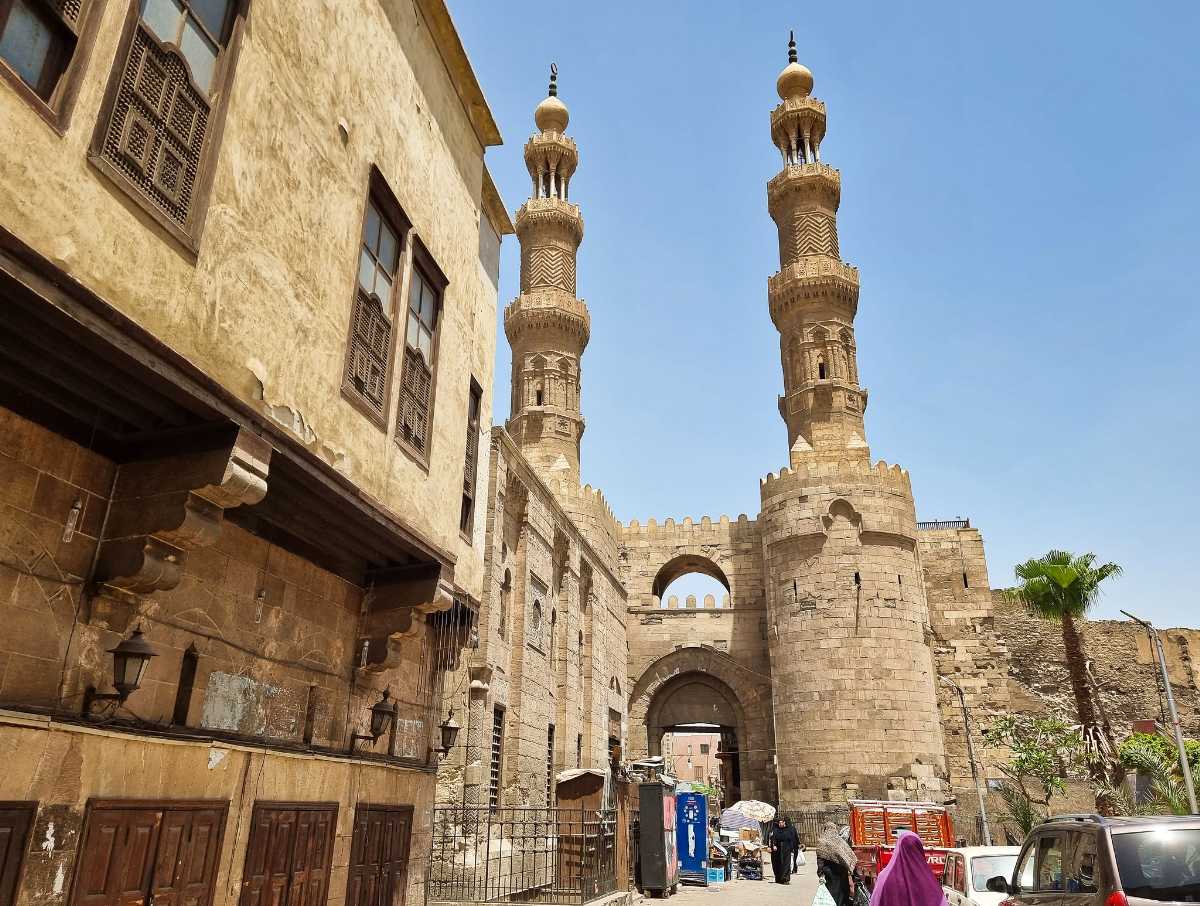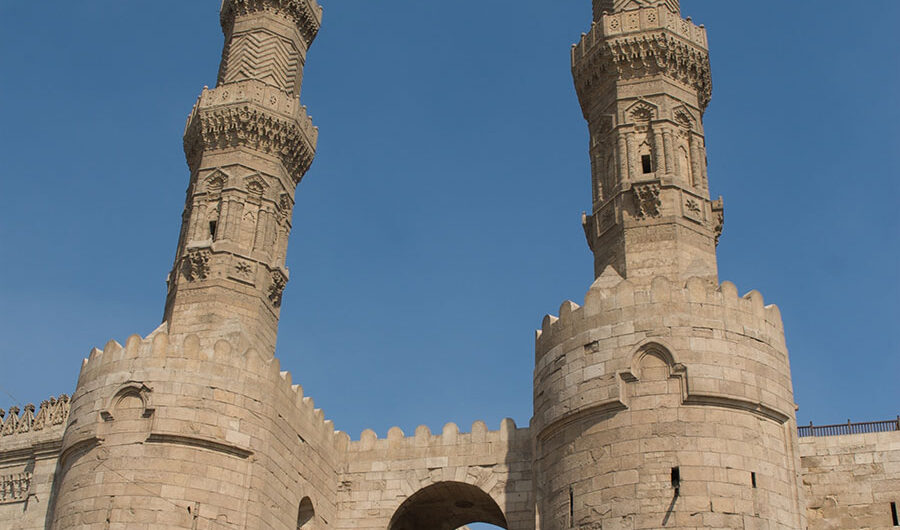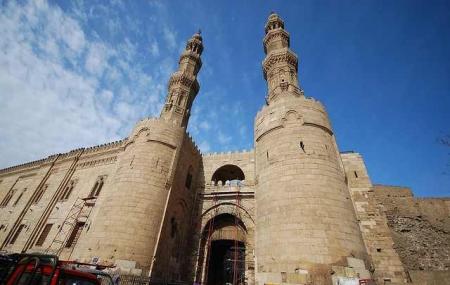A Guide to Bab Zuweila: Cairo's Historic Gate
As one of Cairo's bustling and vibrant neighbourhoods, Bab Zuweila holds a special place in Egypt's rich history. Towering above the bustling streets below, Bab Zuweila's historic gate has stood for over 1,000 years, welcoming visitors worldwide. From the awe-inspiring view from the top of the gate to the fascinating history behind this iconic landmark, there is no shortage of reasons to add Bab Zuweila to your itinerary. In this guide, we'll explore everything you need to know about Cairo's historic gateway, from its cultural significance to tips for making the most of your time there.

Introduction to Bab Zuweila
Welcome to Bab Zuweila, the historical gate of Cairo that still stands tall after over nine centuries. As you approach this remarkable gate, you'll notice the pair of minaret-topped semicircular towers and the lobed-arch decorations on the inner flanks of the towers at the entrance. The gate was built between 1091-92 and was named after members of the Fatimid army who hailed from a North African Berber tribe called the Zuwayli. Bab Zuweila marks the southern end of the Fatimid city, also known as Bab al-Mitwalli. This gate is one of the three remaining gates of Fatimid Cairo, and it's an essential site for history lovers.
As you pass through the massive doorway of Bab Zuweila, you'll realize that the street level has risen so considerably that what you see as you walk would have been at eye level for a traveller entering the city on a camel. According to the renowned architectural historian K.A.C. Creswell, the loggia between the two towers on the outside of the wall once housed an orchestra that announced royal comings and goings. Although Bab Zuweila is now a lively tourist spot, it wasn't always this way. Public hangings and beheadings occurred here, and the last independent Mamluk sultan Tumanbay II was hanged by the conquering Turks in 1517 from this gate.
Bab Zuweila supports two of the finest Mamluk minarets in Cairo (1420), which serve as the mosque of Sultan Mu’ayyad located next door. Looking at Bab Zuweila from within the city, you'll see a gabled roof between the two towers. The inside flanks of the towers contain recessed panels with lobed arches in the Moorish style. A semi-circular gate supporting a gallery stands between the two towers, and above this is a connecting open semi-circular arch that forms a thick-set barrel vault. You can also observe that the vestibule inside the gate was originally flanked by two semi-circular niches but was modified by Mu’ayyad.
Bab Zuweila is an essential tourist attraction featuring some of Cairo's oldest and grandest monuments. This massive gate offers a unique experience, an opportunity to dive into Egypt's rich history and experience it firsthand. Bab Zuweila outlines Cairo's southern limits, and the city has grown beyond this gate quickly. The two minarets that spring from the towers of Bab Zuweila belong to the mosque of Sultan Mu’ayyad, making the gate seem far mightier than the Northern Gates. Careful restoration and cleaning in 2001 revealed the full beauty of the honey-coloured limestone of the gate and the minarets. [1][2]

The History of Bab Zuweila
As you go through the bustling streets of Cairo, you will inevitably come across Bab Zuweila. This historic gate, located in the heart of Old Cairo, has been standing tall for over a thousand years and has seen more than its fair share of Cairo's history.
This impressive structure was built during the Fatimid era in the 11th century and served as one of the main entrances to the city. It was strategically placed as the southern gate, providing access to the southern parts of Egypt. Throughout the centuries, Bab Zuweila has witnessed a great deal of change in the city, from its early Islamic period to the Ottoman era and even the British occupation.
The gate was not only used as a means of defence and protection, but it also became a cultural and commercial hub. Bab Zuweila was the centre of trade and exchange in the middle ages, making it an important destination for merchants and travellers. Additionally, the famous nightly markets around the gate drew in crowds from all over the city.
During the reign of the Mamluk Sultanate, Bab Zuweila was renovated and rebuilt to its current form, with a towering minaret on one side and a watchtower on the other. It wasn't until the 19th century that the gate was modified again to accommodate horse carriages and pedestrians.
Today, Bab Zuweila still stands strong as a testament to the city's rich history and cultural significance. Visitors can enter the gate, take in the stunning views of Cairo from atop its walls, and explore the bustling markets and mosques in the area. It is a must-see destination for any traveller looking to understand Cairo's vibrant and diverse city.

Fatimid Era Cairo
As you approach Bab Zuweila, the southern gate of Fatimid Cairo, you're transported back to when the Fatimid dynasty ruled Egypt. This gate, along with Bab el Futuh on the north side, is a testament to the size of the city during the Fatimid era. Between 973 and 1170, the Fatimids established a city that would eventually become the largest outside of China. Today, Bab Zuweila is the perfect gateway to explore the Islamic history of Cairo.
It's no secret that Cairo's fortified medieval city was built over time as other dynasties added their stonework to the original Fatimid design. Nevertheless, the function of Bab Zuweila as a marker of the Fatimid city's limits remains intact. This gate, built in 1092, is truly an architectural wonder of its time and still stands proudly. The design of the gate appears to be influenced by Byzantine architectural models, a unique blend of Islamic and Christian artistic styles.
If you want to experience a bird's eye view of Cairo, climbing up Bab Zuweila's minarets is a must. The panoramic vistas on offer stretch out to the Citadel and beyond. Take your time exploring this magnificent gate, one of the few remaining old, with its two minarets on top. While Bab Zuweila used to be the city's south gate for many years, it's now a gateway into Cairo's rich Islamic past.
As you walk through Bab Zuweila, you'll be stepping through history. This gate was previously used as the marketplace for alluring goods from the Egyptian Delta. It was also a popular spot for those seeking justice from the Fatimid rulers. This gate has seen it all, and its well-preserved state is a testament to how important it was to the Fatimid rulers of old. So, as you experience this time capsule for yourself, take in the rich history of this place and imagine what life was like during the Fatimid era of Cairo. [5][6]

Bab Zuweila's Role in Marking the City Limits
Bab Zuweila is a historic gate in Cairo that significantly marked the city's limits during the Fatimid dynasty. Together with its counterpart gate on the north side, Bab el Futuh, it reveals the city's impressive size during that time. The Fatimid reign lasted for two centuries, from 973 to 1170. Under further dynasties of Ayyubids and Mamluks, the city grew and transformed. Despite many buildings getting replaced during this period, the two gates remained important markers of Fatimid Cairo's limits. Scholars believe Bab Zuweila's architecture has little Islamic influence and is more reminiscent of Byzantine models.
Climbing the minarets of Bab Zuweila can be a rewarding experience for those interested in history. However, the gate's appearance is equally awe-inspiring from the ground level. Its appearance has been well-preserved, making it one of the most illustrious witnesses of Cairo's past. At the height of its prominence, the city was the largest in the world outside of China, with an estimated population of around 500,000 during the 13th and 14th centuries. This population was much larger than other European cities of that time, such as Paris and Milan, whose populations did not surpass 200,000.
During the Fatimid dynasty, Bab Zuweila's gate was the third one built. It was constructed in 1092 under the reign of the powerful Fatimid vizier, Badr al-Jamali. Al-Jamali was driven to rebuild the city's walls due to threats from various directions, including attempts by Turkoman Atsiz to take Cairo. Each of the three gates in Fatimid Cairo is composed of two massive towers which flank a recessed gateway. The towers are connected above the gateway by a curtain wall, and the gates demonstrate architectural and iconographic features that were unknown in Muslim Egypt.
Bab Zuweila's architecture reveals a newly cultivated taste for stone in Cairo that was introduced during al-Jamali's rule. The Byzantine and North Syrian stone details demonstrate a direct encounter between neighbouring regional building traditions. Spherical-triangle pendentives, rising tunnel vaults, and scalloped-arched panels are some of the distinctive features seen in this gate. The use of the semicircular arch with the complete absence of the pointed arch was unusual in Fatimid Cairo. Arabesque medallions on the panels and towers of Bab Zuweila, along with the medallion on the vault of the loggia above its great archway, represent Fatimid techniques. The gate was named after the Fatimid soldiers from the Berber tribe Al Zawiya who settled near its original location in 969. In the Ottoman period, it was also named Bab al-Mitwalli. Today, Bab Zuweila remains an important historical landmark and a testament to Cairo's rich past. [7][8]

Architectural Style of Bab Zuweila
When you visit Bab Zuweila, you will immediately notice its unique architectural style. Built during the Fatimid period in 1091-92, this historic gate showcases a blend of different regional building traditions. The gate is one of three remaining gates of Fatimid Cairo and is named after the North African Berber tribe called the Zuwayli. Bab Zuweila is also known as Bab al-Mitwalli, which was its name during the Ottoman period. The gate marks the southern end of the Fatimid city, while Bab al-Futuh marks the north, and both serve as the termini for the major north-south spine of the city, al-Muizz Street.
The unique feature of Bab Zuweila is its semicircular towers, topped by minarets and decorated with lobed arches that show influence from North African architecture. The towers are made of solid masonry, with only a few arrow slits and pointed arches for decoration. A gallery connecting with a semi-circular arch was built between the two towers, which was thought to have accommodated musicians for ceremonies. Moreover, the vestibule inside the gate was flanked by two semi-circular niches, but one was altered later.
Bab Zuweila showcases a variety of architectural details, such as scalloped-arched panels, spherical-triangle pendentives, and rising tunnel vaults. These features were unknown in Muslim Egypt, demonstrating the encounter between neighbouring building traditions. The gate's Byzantine and north Syrian stone details and techniques mark the beginning of the newly cultivated taste for stone in Cairo. Despite being a lighthearted spot now, Bab Zuweila was previously used for public hangings and beheadings, with the last Mamluk sultan Tumanbay II hanged here by the conquering Turks in 1517.
When you walk through the massive doorway, consider that the street level has risen, making what you see at eye level for a traveller entering the city on a camel. The honey-coloured limestone of the gate and the minarets were restored and cleaned carefully in 2001, revealing their full beauty. Babylon Fortress, the Hanging Church, and the Khan El-Khalili Bazaar are other nearby attractions to explore when you visit Bab Zuweila. [9][10]

Views from the Minarets of Bab Zuweila
At Bab Zuweila, you can experience incredible views from the top of its minarets. The gate is one of three remaining medieval gates in the old city walls of Cairo and has become a historic landmark. The two impressive minarets flank the gate and provide access to visitors for a nominal fee. While climbing up the spiral staircase can be tight, the view at the top is well worth the effort.
Bab Zuweila, or Zuwayla, dated back to Fatimid Cairo and was completed in 1092 AD. The gate offers visitors a glimpse of Middle Age life, leading them to a bazaar quarter that is still lively. The gate has a rich and sometimes gruesome history - it was a place for public executions, and the heads of criminals were displayed above the gates on spikes. Even the last Mameluke sultan of Egypt, Tumanbay, was hanged at Bab Zuweila in 1517.
As you climb the minarets, you can take in breathtaking views of the surrounding area. While some parts of the neighbourhood are unfortunately neglected, the views are still spectacular. It starkly contrasts the packed and sometimes filthy atmosphere outside the gate. However, the gate remains vital to the city's cultural heritage and is recognized as a UNESCO World Heritage site.
While Bab Zuweila is undoubtedly a significant historic landmark, visitors should know about potential scams around the gate. Some locals may try to approach tourists and ask for money or offer to show them locked rooms inside the mosque that they didn't ask to see. It's best to be wary and stay alert during your visit. Despite potential scams, Bab Zuweila remains a must-visit location in Cairo, providing visitors with a unique insight into the city's vibrant history. [11][12]

Bab Zuweila's Importance to Cairo's History
Bab Zuweila, one of the three remaining gates of Fatimid Cairo, is an important landmark that holds great historical significance. Built-in 1092 during the Fatimid rule, the gate and its adjoining towers were designed to protect the city from Turkish armies. Located in the bustling neighbourhood of Islamic Cairo, it is known as Bab al-Mitwalli to locals. The gate and its towers were the earliest examples of medieval military architecture. The gates have slits that allow soldiers to pour boiling oil on enemy troops, and these gates have seen many changes of power over the past centuries due to their location at a crossroads of trade and travel routes.
The gate's history is not only defined by its architecture but by the artefacts wedged into the cracks and crevices of the walls by travellers for good luck. Items such as human teeth, handwritten notes in a mystical script, Chinese coffee cups with Arabic inscriptions, and Ottoman pipes were discovered during the restoration. Some of these items have been put on display near the gate. Although the gate is now a tourist attraction, it was once a place of public hangings and beheadings. The conquering Turks hung the last independent Mamluk sultan Tumanbay II at the gate in 1517.
The gate truly highlights Cairo's unique architectural history. The minarets of Sultan Mu’ayyad mosque are located near the gate, and the gallery once housed musicians who performed during ceremonial processions. The gate also holds lobed-arch decorations, introduced by Fatimids after their conquest of Egypt, and semi-circular arches that formed a barrel vault. The vestibule of the gate was originally flanked by two semi-circular niches, one of which was later altered by Mu’ayyad.
Despite its age, Bab Zuweila still stands strong as a landmark of Cairo's history. Thanks to its careful restoration, the gate has been preserved and is now a reminder of Cairo's rich and diverse past. Whether you are interested in architecture, history or mysticism, Bab Zuweila is a must-visit destination for any traveller. [13][14]

Restoration of Bab Zuweila
When visiting Cairo, one of the must-see sights is Bab Zuweila, the city's historic gate. Constructed by the Fatimids in 1092, this gate is one of the three surviving gates that provided entry into the fortified medieval city. What makes Bab Zuweila distinct from the other gates are the two elongated minarets that the Mamluk Sultan al-Mu’ayyad Shaykh constructed. It is also known as al-Mitwalli, named after El Kutb al-Mitwalli, a holy man who could teleport himself to the gate and answer the prayers of those seeking assistance for their medical conditions.
Although the gate is a valuable historical site, it is exposed to significant risks from congestion and human activity due to its location in a densely populated city area. In 1998, the American Research Center in Egypt spearheaded an intense five-year conservation project to revitalize the gate with support from the U.S. Agency for International Development. A critical component of the project was the removal, restoration, and re-installation of Bab Zuweila's sizable wood and iron doors, weighing several tons each and measuring 10 feet wide and 19.5 feet tall.
Removing and reinstalling the doors was challenging, as the streets around Bab Zuweila had to close for the task. The doors, composed of solid wood and iron nails, originally operated on a bronze ball bearing system that allowed them to open and close despite their considerable size easily. Local craftsmen and carpenters carefully repaired and conserved the doors under Dieter Hartwig, the project's wood conservator. The metal conservator, Franca Cole, designed a stainless-steel ball bearings system that could support the weight of the doors based on the original bronze ball bearings.
The restoration efforts made an exceptional impact on preserving the authenticity of Bab Zuweila's unique architectural features and spiritual values. ARCE's associate director for Cairo, Michael Jones, said, "We worked meticulously to preserve Bab Zuwayla's integrity and all its original parts. The monument represents the history that has gone on in and around it, and the spiritual value of the doors, in particular, is irreplaceable." The restoration project's success maintains the cultural richness and historical significance of Bab Zuweila for future generations to admire and appreciate. [15][16]

Visiting Bab Zuweila
Welcome to Bab Zuweila, one of Cairo’s historic gates worth visiting. This magnificent gate is part of the original Fatimid fortifications and is located in the Islamic district of Al-Darb al-Ahmar. Two minarets flank the gate, making it the most dramatic one out of the three remaining medieval gates in the old city walls of Cairo.
Please take a moment to explore the surrounding area, known for its bustling bazaar quarter full of life and history. Bab Zuweila was once a venue for dancing, a cure for toothaches, a place for public executions, and the ceremonial pilgrimage caravan to Mecca.
Climb up the spiral staircase to the top of the minarets for a spectacular view of the city, but beware of potential scams from people like Alex, who claims to be an English teacher and historian. If you don't have time for a complete tour, at least walk through the gate and look up as you pass between its massive doors, where local belief has it that the spirit of a certain Ottoman Sheikh Al Mitwali lives in the doorway.
You can also visit the museum upstairs, displaying everyday items found during the street excavation around the door. Consider continuing past the Tentmakers Souk toward The Citadel, the Madrasa Sultan Hassan, and the Mosque of Al Rifai to the scruffy neighbourhood of Darb al Ahmar, where the wall and gate were first constructed.
You can access the gate for a nominal fee, and the area has been painstakingly restored with USAID funding. Don't miss the opportunity to see one of Cairo's most significant landmarks and immerse yourself in the rich history and culture that Bab Zuweila has to offer. [17][18]

Conclusion: Bab Zuweila is a Must-Visit Site in Cairo
When visiting Cairo, add Bab Zuweila to your list of must-visit sites. This historic gate, built in the 11th century, is an important piece of the city's past and is considered a part of the original Fatimid fortifications. It is one of three main portals to the city and is adorned with two beautifully designed minarets from the nearby Al-Mu'ayyad Mosque.
Bab Zuweila was once an execution site during Mamluk times, and its space in front of the gate was used for such purposes. Today, visitors can climb the ramparts of the gate and enjoy the spectacular view of Old Cairo. You can also see intriguing exhibits about the gate's history and climb up the minarets to get an even better view of the area.
This gate played an important role in marking the limits of the Fatimid City, which was once the largest outside of China. Its appearance reflects Byzantine architectural styles rather than Islamic ones, adding to its uniqueness. Even though those constructed by the subsequent dynasties have replaced the buildings belonging to the Fatimid period, Bab Zuweila still stands strong and retains its original appearance.
As one of the most iconic landmarks in Cairo, Bab Zuweila is a must-see site in Islamic Cairo. Its size and grandeur will leave you in awe, and its historical significance will transport you back in time. Don't miss the chance to climb its minarets and take in the breathtaking view or to explore the exhibits about its history. Bab Zuweila is truly a gem of Cairo and will undoubtedly leave a lasting impression on you. [19][20]
